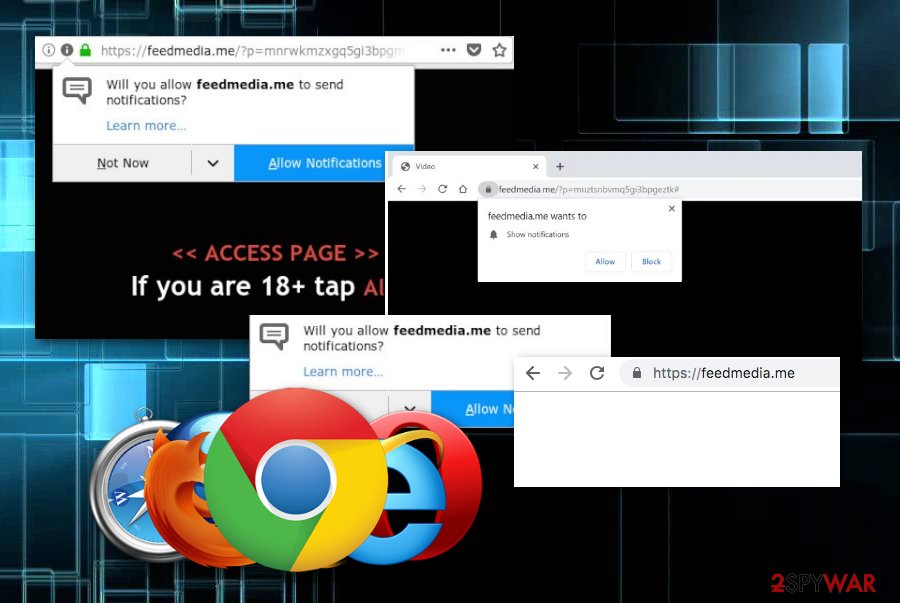Feedmedia.me (Tutorial) - Removal Instructions
Feedmedia.me Removal Guide
What is Feedmedia.me?
Feedmedia.me – a pop-up that infects most vulnerable users and displays intrusive content

Feedmedia.me is considered to be adware which drops pop-up ads on infected web browser apps. First, users usually receive the Push Notifications message which aims to catch subscribers within each click on the “Allow” button. Once a person subscribes to Feedmedia.me pop-up ads, advertising content starts launching during browsing activities. One of the biggest cons of such actions is slowing down the entire system and forcing redirects to affiliate websites.
Feedmedia.me redirects might take the user not only to developer-sponsored content but they might also leave them in malware-laden pages. Here malicious objects might be lurking in third-party hyperlinks and advertisements. If you step on this content, you might be forced to download a particular virus (e.g. Trojan horse, spyware[1]) on your machine.
| Name | Feedmedia.me |
|---|---|
| Program type | Adware |
| App category | Potentially unwanted program |
| Danger level | Low. Does not pose harm itself but can take you to infectious pages |
| Revenue-gaining technique | The pay-per-click technique and user's browsing details |
| Main signs | Redirecting to affiliate pages, advertising during browser sessions, modifying browser apps |
| Affected browsers | Chrome, Firefox, Explorer, Edge, and Safari |
| Distribution tips | Freeware/shareware, third-party websites |
| Removal guide | FortectIntego can automatically delete the PUP |
If some type of dangerous malware approaches your system, you might start facing unpleasant activities and consequences such as identity theft, monetary losses, system sluggishness, software crashes, and so on. The adware itself is not dangerous but people still call it Feedmedia.me virus due to its ability to make the system vulnerable to other cyber infections.
Feedmedia.me pop-up can attack the most used web browser applications, including Chrome, Firefox, Safari, Explorer, and Edge. If this happens, you will probably experience the homepage and new tab modifications. Also, a big number of advertisements surely will approach during your browsing and relate to the decrease in your computing work quality.

Furthermore, Feedmedia.me pop-ups might promote misleading offers and deals throughout its advertisements. Adware is known for suggesting downloads of third-party computer cleaning software and similar apps. We urge not to trust these claims as you might regret spending your money on useless products afterward.
Nevertheless, this is not all that Feedmedia.me might be capable of. Adware applications can also track your browsing activity and gather all details that are related to it. These PUPs[2] find out what kind of websites you are likely to browse in, what kind of offers you commonly search for, and create adverts that rely on this information.
This way Feedmedia.me fulfills the developers' needs as the more attractive the notification seems, the more the clicks it receives. Clicking on every advertisement fills the creator's pockets. This deceptive marketing technique is well-known as the pay-per-click or cost-per-click[3] method that is commonly used through adware spreaders.

Due to all the suspicious activities that we have presented, we hope that you started to consider the Feedmedia.me removal as necessary. If you have been bothered by this application lately, you should take specific actions and terminate it from the system. For easier and safer removal, we recommend downloading and installing a tool such as FortectIntego.
Also, you can remove Feedmedia.me with a step-by-step guide that we have provided at the end of the article. However, make sure to measure your skills before completing the elimination by yourself as this process requires more of the user's attention and effort. So, make sure that you will be able to handle all these things correctly.
Prevention tips for potentially infectious content
Adware applications, browser hijacker, scareware, scams, and other potentially unwanted programs have the same distribution techniques. According to tech specs,[4] all of these PUPs are often spread with the help of bundling or inserting them into third-party hyperlinks/advertisements. If you want to protect your computer from these apps, take all precautionary tips seriously:
- Go for the Custom or Advanced installation mode only. This configuration will allow you to take full control of all incoming downloads and prevent unknown content from slipping into the computer system.
- Keep a distance from all unknown content. Avoid third-party websites, including free torrent downloading pages, where the risk of an adware infection is the highest.
- Keep all of your software and products updated regularly. Make sure that you perform required updates for all of your software, especially, antimalware/antivirus tools.
- Make sure to purchase a reliable antivirus program. Do not be afraid to invest in a more expensive but truly trustworthy antimalware as you will not regret it.
Always keep in mind that you have to put some effort in order to protect your computer system at a higher level. If you do not do so, you will supposedly experience various risks of infections and system errors.
Guidelines for manual and automatical Feedmedia.me removal
Feedmedia.me removal is not such a difficult process to perform as it would be for a ransomware virus. However, this does not mean that you should proceed with it carelessly. If you are taking the manual elimination method, this includes carefully cleaning and optimizing web browsers such as Google Chrome, Mozilla Firefox, Internet Explorer, Safari, and MS Edge.
However, our suggestion would be to remove Feedmedia.me virus from the operating system and web browsers with the help of antimalware software. These programs include an advanced threat removal feature that allows eliminating infectious content from all over the computer system and its applications. Furthermore, do not forget to reverse suspicious changes in your browser apps. You can do this by following these instructing steps:
- Launch your web browser icon and find Menu.
- Go to Settings and opt for the Advanced option.
- Locate Privacy and Security and select Content Settings.
- Afterward, choose Notifications.
- Locate all suspicious URLs such as Feedmedia.me, then choose Block or Remove for all the questionable-looking pages discovered.
You may remove virus damage with a help of FortectIntego. SpyHunter 5Combo Cleaner and Malwarebytes are recommended to detect potentially unwanted programs and viruses with all their files and registry entries that are related to them.
Getting rid of Feedmedia.me. Follow these steps
Uninstall from Windows
Remove suspicious objects from your Windows computer system with the help of this instructing guide:
Instructions for Windows 10/8 machines:
- Enter Control Panel into Windows search box and hit Enter or click on the search result.
- Under Programs, select Uninstall a program.

- From the list, find the entry of the suspicious program.
- Right-click on the application and select Uninstall.
- If User Account Control shows up, click Yes.
- Wait till uninstallation process is complete and click OK.

If you are Windows 7/XP user, proceed with the following instructions:
- Click on Windows Start > Control Panel located on the right pane (if you are Windows XP user, click on Add/Remove Programs).
- In Control Panel, select Programs > Uninstall a program.

- Pick the unwanted application by clicking on it once.
- At the top, click Uninstall/Change.
- In the confirmation prompt, pick Yes.
- Click OK once the removal process is finished.
Delete from macOS
Remove items from Applications folder:
- From the menu bar, select Go > Applications.
- In the Applications folder, look for all related entries.
- Click on the app and drag it to Trash (or right-click and pick Move to Trash)

To fully remove an unwanted app, you need to access Application Support, LaunchAgents, and LaunchDaemons folders and delete relevant files:
- Select Go > Go to Folder.
- Enter /Library/Application Support and click Go or press Enter.
- In the Application Support folder, look for any dubious entries and then delete them.
- Now enter /Library/LaunchAgents and /Library/LaunchDaemons folders the same way and terminate all the related .plist files.

Remove from Microsoft Edge
Delete unwanted extensions from MS Edge:
- Select Menu (three horizontal dots at the top-right of the browser window) and pick Extensions.
- From the list, pick the extension and click on the Gear icon.
- Click on Uninstall at the bottom.

Clear cookies and other browser data:
- Click on the Menu (three horizontal dots at the top-right of the browser window) and select Privacy & security.
- Under Clear browsing data, pick Choose what to clear.
- Select everything (apart from passwords, although you might want to include Media licenses as well, if applicable) and click on Clear.

Restore new tab and homepage settings:
- Click the menu icon and choose Settings.
- Then find On startup section.
- Click Disable if you found any suspicious domain.
Reset MS Edge if the above steps did not work:
- Press on Ctrl + Shift + Esc to open Task Manager.
- Click on More details arrow at the bottom of the window.
- Select Details tab.
- Now scroll down and locate every entry with Microsoft Edge name in it. Right-click on each of them and select End Task to stop MS Edge from running.

If this solution failed to help you, you need to use an advanced Edge reset method. Note that you need to backup your data before proceeding.
- Find the following folder on your computer: C:\\Users\\%username%\\AppData\\Local\\Packages\\Microsoft.MicrosoftEdge_8wekyb3d8bbwe.
- Press Ctrl + A on your keyboard to select all folders.
- Right-click on them and pick Delete

- Now right-click on the Start button and pick Windows PowerShell (Admin).
- When the new window opens, copy and paste the following command, and then press Enter:
Get-AppXPackage -AllUsers -Name Microsoft.MicrosoftEdge | Foreach {Add-AppxPackage -DisableDevelopmentMode -Register “$($_.InstallLocation)\\AppXManifest.xml” -Verbose

Instructions for Chromium-based Edge
Delete extensions from MS Edge (Chromium):
- Open Edge and click select Settings > Extensions.
- Delete unwanted extensions by clicking Remove.

Clear cache and site data:
- Click on Menu and go to Settings.
- Select Privacy, search and services.
- Under Clear browsing data, pick Choose what to clear.
- Under Time range, pick All time.
- Select Clear now.

Reset Chromium-based MS Edge:
- Click on Menu and select Settings.
- On the left side, pick Reset settings.
- Select Restore settings to their default values.
- Confirm with Reset.

Remove from Mozilla Firefox (FF)
Remove dangerous extensions:
- Open Mozilla Firefox browser and click on the Menu (three horizontal lines at the top-right of the window).
- Select Add-ons.
- In here, select unwanted plugin and click Remove.

Reset the homepage:
- Click three horizontal lines at the top right corner to open the menu.
- Choose Options.
- Under Home options, enter your preferred site that will open every time you newly open the Mozilla Firefox.
Clear cookies and site data:
- Click Menu and pick Settings.
- Go to Privacy & Security section.
- Scroll down to locate Cookies and Site Data.
- Click on Clear Data…
- Select Cookies and Site Data, as well as Cached Web Content and press Clear.

Reset Mozilla Firefox
If clearing the browser as explained above did not help, reset Mozilla Firefox:
- Open Mozilla Firefox browser and click the Menu.
- Go to Help and then choose Troubleshooting Information.

- Under Give Firefox a tune up section, click on Refresh Firefox…
- Once the pop-up shows up, confirm the action by pressing on Refresh Firefox.

Remove from Google Chrome
Removal of adware-based objects on Google Chrome can be performed with the help of these instructions:
Delete malicious extensions from Google Chrome:
- Open Google Chrome, click on the Menu (three vertical dots at the top-right corner) and select More tools > Extensions.
- In the newly opened window, you will see all the installed extensions. Uninstall all the suspicious plugins that might be related to the unwanted program by clicking Remove.

Clear cache and web data from Chrome:
- Click on Menu and pick Settings.
- Under Privacy and security, select Clear browsing data.
- Select Browsing history, Cookies and other site data, as well as Cached images and files.
- Click Clear data.

Change your homepage:
- Click menu and choose Settings.
- Look for a suspicious site in the On startup section.
- Click on Open a specific or set of pages and click on three dots to find the Remove option.
Reset Google Chrome:
If the previous methods did not help you, reset Google Chrome to eliminate all the unwanted components:
- Click on Menu and select Settings.
- In the Settings, scroll down and click Advanced.
- Scroll down and locate Reset and clean up section.
- Now click Restore settings to their original defaults.
- Confirm with Reset settings.

Delete from Safari
Remove unwanted extensions from Safari:
- Click Safari > Preferences…
- In the new window, pick Extensions.
- Select the unwanted extension and select Uninstall.

Clear cookies and other website data from Safari:
- Click Safari > Clear History…
- From the drop-down menu under Clear, pick all history.
- Confirm with Clear History.

Reset Safari if the above-mentioned steps did not help you:
- Click Safari > Preferences…
- Go to Advanced tab.
- Tick the Show Develop menu in menu bar.
- From the menu bar, click Develop, and then select Empty Caches.

After uninstalling this potentially unwanted program (PUP) and fixing each of your web browsers, we recommend you to scan your PC system with a reputable anti-spyware. This will help you to get rid of Feedmedia.me registry traces and will also identify related parasites or possible malware infections on your computer. For that you can use our top-rated malware remover: FortectIntego, SpyHunter 5Combo Cleaner or Malwarebytes.
How to prevent from getting adware
Stream videos without limitations, no matter where you are
There are multiple parties that could find out almost anything about you by checking your online activity. While this is highly unlikely, advertisers and tech companies are constantly tracking you online. The first step to privacy should be a secure browser that focuses on tracker reduction to a minimum.
Even if you employ a secure browser, you will not be able to access websites that are restricted due to local government laws or other reasons. In other words, you may not be able to stream Disney+ or US-based Netflix in some countries. To bypass these restrictions, you can employ a powerful Private Internet Access VPN, which provides dedicated servers for torrenting and streaming, not slowing you down in the process.
Data backups are important – recover your lost files
Ransomware is one of the biggest threats to personal data. Once it is executed on a machine, it launches a sophisticated encryption algorithm that locks all your files, although it does not destroy them. The most common misconception is that anti-malware software can return files to their previous states. This is not true, however, and data remains locked after the malicious payload is deleted.
While regular data backups are the only secure method to recover your files after a ransomware attack, tools such as Data Recovery Pro can also be effective and restore at least some of your lost data.
- ^ Spyware. Malwarebytes. Relevant technology information.
- ^ Margaret Rouse. PUP (potentially unwanted program). Search Security. Tech Target.
- ^ Larry Kim. CPC: What Is Cost Per Click?. Word Stream. Online advertising made easy.
- ^ Bedynet.ru. Bedynet.ru. Virus news and removal guide.























